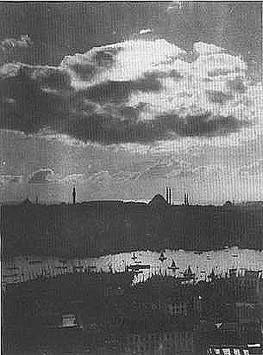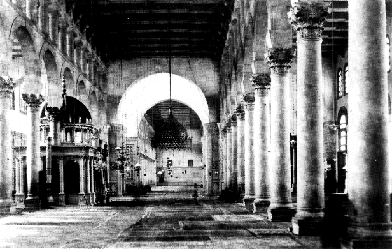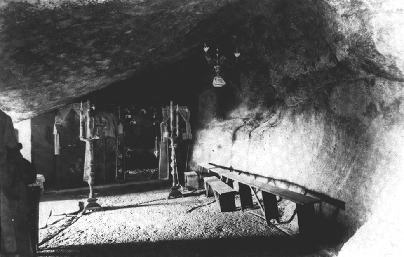 Constantinople
ConstantinopleKelsey's journey began in Europe, then continued through the Near East including extended stays in parts of Egypt, Greece, Syria and Turkey.
As explained in a letter of 1918, Kelsey's 1919-1920 expedition had several goals: to visit important archaeological sites previously or currently under investigation, to photograph and survey possible sites for future University of Michigan excavations, to photograph monuments and artifacts for later study at the University, and to collect artifacts--chiefly ancient and mediaeval manuscripts of Christian cultures of the Near East. In addition, Kelsey intended to photograph persons of Near Eastern and Eastern European ethnic origin. Outside the realm of archaeology proper, Kelsey also planned to photograph missionary efforts and to write about them.
Ultimately, the expedition had a smaller staff than Kelsey had envisioned. He had no Orientalist and no missionary physicians on staff. The party consisted of a photographer, G.R. Swain, and a photographer's assistant, Easton T. Kelsey (Francis Kelsey's son; at some stages they were joined by Francis Kelsey's wife, Isabel). Despite the small staff, the expedition was successful in each of its numerous endeavors. It did manage to start early enough to take advantage of the aftermath of the Great War; that is, to travel with military protection and aid, and to buy rare manuscripts at prices forced low by the desperate positions of their owners.
While abroad Kelsey was moved by the horrible realities of the situation upon which his abstract speculations had been based. The work of the Red Cross, the Near East Relief, the Young Men's Christian Association and other similar organizations consumed much of his time. He not only travelled with people who worked for these charitable organizations, but also visited their projects and saw for himself the refugee camps, orphanages and training schools for Syrians, Greeks and Armenians. He spoke extensively with the missionaries and with their charges, collecting information for a series of newspaper and journal articles. Circumstances impelled him to involve himself in various political and military activities as well.
Part Two illustrates the diverse projects of Kelsey's 1919-1920 Near Eastern Expedition by two thematic groupings of letters, photographs, and artifacts. The first group treats the whole of the expedition according to its itinerary. The second group focuses on Kelsey's involvement with Armenia. As in Part One of this exhibition, the brief identifications for each photograph are taken from the notes of Kelsey and Swain.
* * *
The expedition began in Europe due, in part, to the demands of travel arrangements. They boarded the train in Paris and, by numerous connections, made their way across the north of Eastern Europe.
The fact that the Near Eastern Expeditions began in Europe is also indicative of Kelsey's special scholarly interest in the Roman Empire. The first investigative visits of the expedition were made in France at locations which had been, two thousand years before, the battlefields of Julius Caesar, in order to see what remained of the ancient sites of combat. Kelsey and those in his party were struck by the horrific irony that those ancient battlefields bore traces of the recent Great War as well.
In addition, while in Europe Kelsey acquired rare Christian manuscripts from the Near East which had been dispersed as a result of the recent hostilities.
* * *
Kelsey continued his search for traces of Roman history in the Near East.
The first stage of the Near Eastern Expedition was in Istanbul. True to his background as a classicist, Kelsey consistently sought evidence of the city's Roman past.
During the middle ages Istanbul had been the premier capital city of the Eastern Roman, or Byzantine Empire (330 -1453 A.D.). The Byzantine Empire was the longest-lived and most extensive Christian empire of mediaeval times, and its capital supplanted Rome in secular and, for much of the Near East, in religious authority. Old Rome was, in effect, replaced. In the face of opposition by the powerful pagan senatorial class of Rome, in 324 A.D. the Christian Roman emperor Constantine moved his capital from the city of Rome to Byzantium, a military outpost on the Bosporos. There he founded a Christian city which was named New Rome, but which was called, after his illustrious self, Constantinople.
Kelsey, along with most of his contemporaries, continued to call the city Constantinople rather than Istanbul, the name used during later Ottoman rule (1453-1918 A.C.) up to the present day. His informed selection of the name Constantinople is an indication that, in his mind, his itinerary took him from Old the New Rome.
 Constantinople
Constantinople
From the Galata Tower, toward Stamboul, into the light. Mosques on skyline. Glint of Sea of Marmar in the distance
December 5, 1919
Photograph by G.R. Swain
(Swain's notes)
In Istanbul, Kelsey began all the expedition's projects as planned. He had Swain photograph the city, its ancient, mediaeval and modern monuments, and its people -- touristically, as actors on the stage for the modern city, and anthropologically, as types of ethnic groups found in the Near East. He continued to collect Christian manuscripts. He began to visit missionary establishments in order to document their work.
Church of Saint Sophia, Istanbul, Turkey
More importantly, for the future successes of the remainder of the expedition, Kelsey went to the United States Embassy where he made the necessary connections, via Rear Admiral Mark Bristol, U.S. High Commissioner of the city, for official permissions, letters of introduction, arrangements for transportation and general advice. With Bristol's help, after very little time in the city, Kelsey had undertaken two additional projects: he drew up a new plan for the city in which he suggested that the city rid itself of its beautiful but unsafe 19th-century wooden architecture; and he became interested in covert military studies the nature of which has not yet been determined but seems to have had something to do with naval intelligence.
* * *
After less than a month, Kelsey and his part left the capital city of Istanbul for the countryside. They travelled first across the Bosphorus to Asia Minor via U.S. destroyer, thanks to Admiral Bristol, then down into southern Turkey, Cilicia, on the re-tooled Berlin-Bagdad railway. Stops in Tarsus, Aintab, and Adana satisfied both archaeological and missionary goals. The overlapping pagan and Christian periods were very much in the forefront of Kelsey's thoughts, as is manifest in the sites he chose to visit.
"Saint Paul's Gate," Tarsus, Turkey
Francis W. Kelsey in the Temple of Zeus, Baalbek, Syria
* * *
In Syria and Palestine, as in Turkey, the Expedition undertook four major archaeological projects: collecting artifacts, taking ethnographic photographs, visiting on-going popular sites and excavations (in this case pagan Graeco- Roman and Christian Byzantine, and Islamic which he associated with earlier Christian structures) and surveying sites for possible future investigation by the University of Michigan. The documentation of missionary work continued apace.

Great Mosque, interior, along the nave, tomb of John the Baptist at left.
Shows rugs on the floor, and beamed roof.
January 18, 1920
Photograph by G. R. Swain
Neg. 7.232
(Swain's notes)
* * *
Predynastic Egyptian amulet in the shape of a
lion's head
Middle Kingdom Ushabti
Roman period mummy mask
* * *

"Cave of the Apocalypse," Patmos, Greece
Grotto of the Convent of the Apocalypse, where St. John is supposed to have
composed Revelations. Tiny chapel at end. Grotto is in native rock
May 1920
Photograph by G. R. Swain
Neg. 7.389
(Swain's notes)